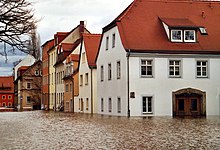Elbe floods in 2006

The Elbe floods in March and April 2006 belonged to almost the entire course of the river to the strongest floods that have ever been measured on the Elbe and thus differs from the normal spring floods for the Elbe , which are triggered by thaw in the upper reaches. Among other things, the Czech tributaries Moldau and Eger , parts of the two Mulde rivers and almost the entire course of the Elbe from Hradec Králové ( Königgrätz ) via the Czech and Saxon upper reaches to the north German middle and lower reaches were affected . Especially in the lower middle reaches the flood is comparable to the flood of 2002 , but it ran through the river in a much longer tidal wave.
At the beginning of April, some cities, such as Hitzacker in Lower Saxony, were largely flooded. The mark of the flood of the century of 2002 was reached or even exceeded in some places. In Lauenburg this already happened on April 7th.
Cause and trigger
The trigger for the flood was a strong thaw in the low mountain ranges on the upper reaches of the Elbe. In the ridges of the Ore Mountains , the Central Bohemian Mountains and in the Bohemian Forest and the Giant Mountains , snow depths of over 1.5 meters accumulated throughout winter. Due to the previous short thawing processes and the long idle time, the snow was comparatively strongly compressed and rich in water. At the end of March, a sharp jump in temperature and high precipitation led to the rapid melting of the snow masses. Precipitation in the Ore Mountains was comparatively low, so that there was no dangerous flood in the tributaries of the upper Elbe. At the beginning of March, floods occurred in these bodies of water, which were more dangerous due to the ice displacement. Heavy precipitation fell at the end of March, particularly in the south of the Czech Republic and in the central Bohemian Basin.
For the strong swelling of the river in the lower middle reaches further causes have to be looked for. On the one hand, dykes in the southern central reaches, especially in Saxony-Anhalt, have been increased and renewed on entire stretches since 2002. These withstood the Elbe and prevented the retention areas from being flooded as they did in 2002. This goes hand in hand with unfavorable river barriers. Another reason for exceeding the high water mark of 2002 north of Magdeburg is the stretched tidal wave, which simultaneously triggered the highest alarm levels on the several hundred kilometers long stretch from Lower Saxony to the mouth of the Vltava. In the middle course, the flow velocity decreased, which resulted in a compression of the wave.
affected areas
Czech Republic
In the southern Czech Republic , several tributaries of the Elbe crossed; large areas had to be evacuated. The Elbe itself rose so high that there were evacuations. In the Czech Republic, several people were killed when the rivers flooded.
Saxony


The very elongated flood peak happened in Saxony between April 1st and 5th. In Dresden the level was 7.49 on April 4, about 2 meters below the record level of 2002. For some districts of Dresden ( Kleinzschachwitz , Pillnitz , Laubegast and Gohlis ) as well as for numerous communities in the districts of Saxon Switzerland , Meißen and Torgau -Oschatz disaster alarm will be triggered. Apart from disruptions in road traffic (closure of numerous riverside streets and the Loschwitz Bridge ), Dresden was little affected by the flood. The district of Gohlis, whose dike is designed to 7.40 meters, was most at risk. The cities of Bad Schandau , Pirna and Meißen were flooded more than Dresden . Most of the damage in Dresden was caused by flooded cellars, even if there were houses flooded , as in Zschieren .
In Dresden, the level of the Elbe was still on April 18, i.e. 2 weeks after passing through the apex, at almost 5 meters, more than twice as high as normal and thus remained in the flood level range for weeks.
Saxony-Anhalt and Brandenburg
In Saxony-Anhalt and Brandenburg , the dikes withstood the flood. After the floods in 2002, the dike systems on the Elbe were renewed along entire stretches, especially in these two countries. Magdeburg could be relieved by the Elbe flood canal .
In both countries, the elongated flood peak was more of a threat because it caused high pressure to act on the dikes for a very long time.
Lower Saxony and Schleswig-Holstein
In Lower Saxony , Hitzacker was particularly badly flooded. The water there was higher than in 2002. Hitzacker is not protected by any dykes and was flooded in the entire city center.
Parts of the old town of Lauenburg in Schleswig-Holstein were also flooded by the Elbe.


